#Adyghe culture
Text
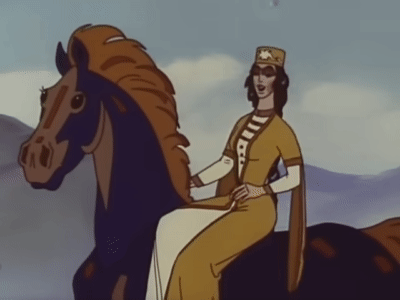

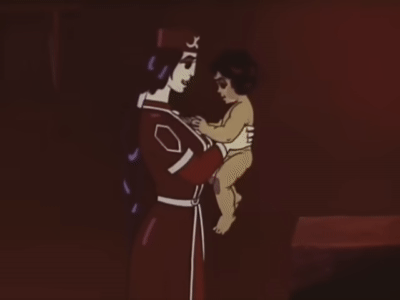


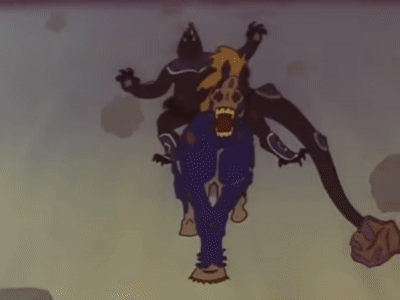


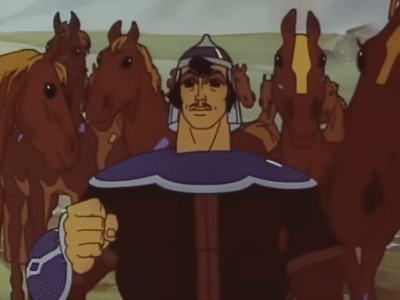
"Сын Камня". Son of stone. 1982
based on the Adyghe tales about Narts
по мотивам адыгский сказаний о нартах
#Caucasian#non-russian#indigenous russian#indigenous russia#Adyghe#Адыги#Adyghe culture#Культура Адыги#artist#cartoon#art
70 notes
·
View notes
Text
The Circassian superwoman: ✨Lashin✨


In our folklore we have a story of a woman named Lashin who had extraordinary strength that she defeated the mongol’s strongest wrestler.
The Mongol army who around that time swept through the north Caucasus challenged the Circassians to bring in their strongest wrestler to fight their wrestler Qaisin.
The Circassian chose a woman named Lashin and dressed her up in men’s clothing to disguise her. Lashin was able to pick up Qaisin, defeated him and emerged victorious. It was said the reason why they chose her is that her father in law once witnessed Lashin pick up a big cow in anger and managed to throw that cow several distances away.
The Circassians later revealed her identity and this time requested another duel without her disguise. Out of fear the Mongols declined and retreated from Circassia.
It was said the duel took place near the chegum river known as Lashinqey named after her.
The story does have different versions with minor differences.
#circassian#folklore#culture#Caucasus#adyghe#Abkhazian#female icons#history#classical mythology#West Asia#eastern europe#Lashin#female figure#warrior#wrestler#cultural identity#folk culture#Female wrestler#female fighter#women in history#womenempowerment#women#kavkaz
15 notes
·
View notes
Text
Adygea Indigenous
#indigenous#indigenous russian#culture#indigenous russia#russia#important#colonization#fypシ#fypage#landback#adygea#adyghe#circassian#Beautiful#indigenous people#indigenous culture#ethnic minorities
32 notes
·
View notes
Text
youtube
Елэ-Елэ. Черкесская ритуальная песня | Ele-Ele. Circassian ritual song
Тимур Кодзоков, Дайана Кулова, Алан Шеуджен
Черкесская (адыгская) ритуальная песня вызова дождя
Инструменты: шичепшин (шыкIэпшынэ), пхачич (пхъэцIыкI), аккордеон (пшынэ)
Август 2022, Кабардино-Балкария
Timur Kodzokov, Diana Kulova, Alan Sheudzhen
Circassian (Adyghe) ritual song calling rain
Instruments: shichepshin (шыкIэпшынэ), pkhachich (пхъэцIыкI), accordion (пшынэ)
August 2022, Kabardino-Balkaria
1 note
·
View note
Text


For centuries Western society memetically held that the most attractive women in the world were the Circassians (today called the Adyghe), a small ethnic group from the Caucasus region around Georgia, Russia, Turkey, and Armenia. In the 1860s it occurred to PT Barnum that while culturally his audiences had been taught that Circassians were the hottest women in the world, almost none of them had actually seen one, so he had some women with roughly the right skin, hair, and eye colors pose as Circassian Beauties. FOR SOME REASON THOUGH he decided that they should have big fluffy hair--a trait that was not present in any of the historical descriptions nor in actual members of the ethnic group, unless possibly he got confused by big Russian fur hats--which they achieved by washing their hair in beer and teasing out like this, to the point that other shows like Barnum's copied the entire bit.
7 notes
·
View notes
Text
CAUCASUS & IRANIAN RESOURCES
The Anthropological Masterlist is HERE.
The Caucasus, or Caucasia, is a region that serves as a barrier between East Europe and West Asia.
ARMENIA ─ “The Armenian people are a West Asian people. They are native to the Armenian Highlands.”
─ Armenian Literature
─ Armenian History
─ Armenian Dictionary
AZERBAIJAN ─ “The Azerbaijani, or Azeri, people are a Caucasian and Turkic people. They are native to the Republic of Azerbaijan and northwestern Iran.”
─ Azerbaijani Culture
─ Azerbaijani Literature
─ Azerbaijani History
CIRCASSIA ─ “The Circassians, or the Adyghe, are a Caucasian people. They are native to Circassia in the North Caucasus.”
─ Circassian Information
─ Circassian Dictionary (Pages 229 - 430)
─ Circassian Re-Immigration to the Caucasus
GEORGIA ─ “The Georgians, or Kartvelians, are a Caucasian people. They are native to Georgia and the southern Caucasus.”
─ Georgian Culture (in German)
─ Georgian Mythology
─ Georgian Dictionary (in Georgian)
URARTU ─ “Urartu, or the Kingdom of Van, was a West Asian civilization that lived from 860 B.C.E. to 590 B.C.E. They lived in the Armenian Highlands.”
─ Urartian Information
─ Urartian History
VAINAKH ─ “The Vainakh, or Nakh, people are a Caucasian people. They are native to the North Caucasus.”
─ Ingush Information
─ Nakh Language
Iran is a West Asian country that is bordered by Iraq and Turkey. It is home to some of the oldest civilizations and most prolific cultures.
INDO-IRAN ─ “The Indo-Iranian, or Aryan, people are an Indo-European people. They are native to Western Asia and eastern Anatolia.”
─ Indo-Iranian Mythology
─ Indo-Iranian Dictionary
OSSETIA ─ “The Ossetians, or Ossetes, are an Iranian people. They are native to Ossetia.”
─ Ossetian Information
─ Ossetian Language (in Russian)
PERSIA ─ “The Persian people are an Iranian people. They are native to Iran.”
─ Iranian Culture
─ Persian Literature
─ Persian Dictionary
SCYTHIA ─ “The Scythian people were a nomadic Iranian people that lived from the 7th century B.C.E. to the 3rd century B.C.E. They lived in Ukraine and southern Russia.”
─ Scythians and the Achaemenid Empire
─ Origin of the Scythians Myth
YAZIDI ─ “Yazidism, or Sharfadin, is an Iranian religion. It originates in Kurdistan.”
─ Yazidi Information
─ Yazidi Culture
─ The Yazidi Black Book
ZOROASTRIANISM ─ “Zoroastrianism is a Persian religion. It originates in Iran.”
─ Zoroastrian Information
─ Zoroaster Information
─ Avesta
#resources#caucasus#iran#armenia#azerbaijan#circassia#georgia#urartu#vainakh#indo-iran#ossetia#permanent slave#scythia#yazidi#zoroastrianism
145 notes
·
View notes
Note
Likewise.
Hence why I plan on learning Syriac.
Like I said.
Outside of the Assyrian communities very few people speak it, aside from maybe some Maronites and some Indian Syriac Christians in Kerala.
Plus I figure I may as well learn something what with me being an Irishman what can’t speak Irish.
In addition to Syriac I also have plans to learn Armenian.
And perhaps even Navajo, Basque, Chuvash, Georgian and Adyghe (a Circassian language). Hypothetically…
My dream is to learn a million languages but I really doubt that’ll happen. I’m gonna try to get Hebrew down and after that I think I can get Arabic. Idk what other Semitic languages there are but I can probably get then. Idk what after that if anything.
I should’ve started with Spanish or something but I’m Ashkenazi Jewish so I have more cultural connection to Hebrew. Also considering languages from my European heritage (German, Russian, Ukrainian, Polish, Yiddish) but idk.
I also have a friend who’s Armenian, which is neat. We’ve only talked about that once tho and I probably don’t want to push her on that.
6 notes
·
View notes
Text
Insight into Kabardian (/kəˈbɑːrdiən/)
What is the language called in English and the language itself?
- In English, it’s called Kabardian or Adyghe. In the language itself, it’s called Къэбэрдей (Qəbərtay) or Адыгэбзэ (Adıgabzə). It may also be called Qabardejbza, Circassian, or Cherkessia.
- The two main dialects of this language are Kabardian and Besleney. Linguists often refer to the Kabardian dialect as East Circassian and the Besleney dialect as West Circassian.
- The Kabardian language and the Adyghe language are very closely intertwined. Although the name in the language itself can be called either in Kabardian, there are significant phonological, typograpical, and cultural differences that should not be conflated.
Where is the language spoken?
- The language is mostly spoken in Russia in Kabardino-Balkaria and Karachay-Cherkessia, roughly where Russia touches Georgia. It’s also spoken in Turkey, Jordan, and Syria due to diaspora.
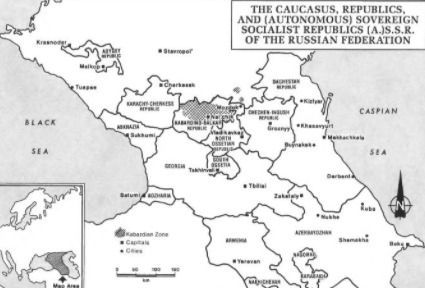
How many people speak the language?
- Kabardian has roughly 650,000 as of 2010 (Endangered Language Alliance).
Which language family does it belong to? What are some of its relative languages?
- It’s classified as Northwest Caucasian > Circassian > Kabardian. It’s closest relative language is Adyghe.
What writing system does the language use?
- Kabardian is written in the cyrillic script.
- Sample text from Omniglot: ЦIыху псори щхьэхуиту, я щIыхьымрэ я хуэфащэхэмрэкIэ зэхуэдэу къалъхур. Акъылрэ зэхэщIыкI гъуазэрэ яIэщи, зыр зым зэкъуэш зэхащІэ яку дэлъу зэхущытын хуейхэщ.
- How to identify the language: A characteristic to look for is dipthongs with “I” as the second character. Though it’s not an exact science, it’ll help you estimate in which group the language you’re looking at is.
What kind of grammatical features does the language have?
- Kabardian is an SOV langauge with ergative-absolutive alignment. It has no grammatical gender, 2 numbers, 3 persons, 5 voices (nominative, causative, factitive, and involuntative), and 4 cases (still under debate). It has definiteness, transitivity, reflexivity, and postpositions in place of prepositions, as well as a small number of particles and conjunctions. It’s also well known for it’s consonant clusters.
What does the language sound like?


undefined
youtube
What do you personally find interesting about the language?
- Once again the dialect debate has me interested. However, I was also intrigued by the use of ergative-absolutive alignment; I haven’t seen that for a long time, and this was a nice refresher! Also, languages from the caucases always intrigue me for some reason.
5 notes
·
View notes
Video
Adyghe dance
128 notes
·
View notes
Photo
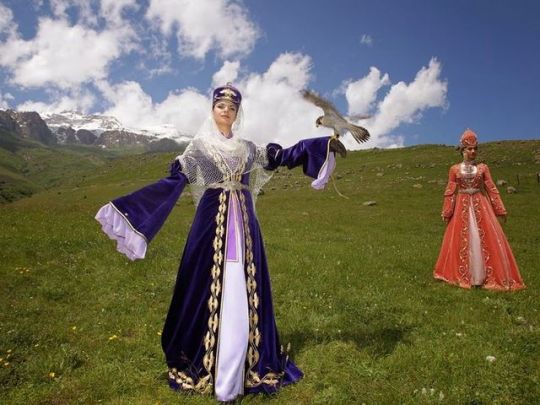
Women dressed in Adyghe (Circassian) traditional clothing
121 notes
·
View notes
Text
Re: the conversation on the colonialism and racism of cottagecore, it's very clear that Europeans think indigenous people don't exist where they live or that they're indigenous because they're Irish or whatever the fuck, so as a Vaqueira, I think it’s time Europeans start understanding whose land they’re on and that there are indigenous people everywhere, so i've made a short, incomplete list of indigenous and nomadic peoples of Europe. Feel free to look up more about them, especially if you're living on their land:
Abazins (Russia, Georgia, Abkhazia)
Adyghe/Circassian people (Russia, Turkey)
Aromanians/Vlachs (Greece, Romania, Albania, Serbia, North Macedonia, Bulgaria)
Ashkali Romani (Kosovo, Albania, North Macedonia)
Avars (Russia)
Balkars (Russia)
Bashkirs (Russia)
Basque people (Spain, France)
Bats people (Georgia)
Bergitka Romani (Poland, Slovakia, Hungary)
Boyash Romani (Romania, Hungary, Croatia, Serbia, Slovakia)
Boykos (Ukraine, Hungary, Slovakia, Poland)
Calé Romani (Spain, Portugal, France)
Cascarot Romani (France, Spain)
Chechens (Chechnya, Russia)
Crimean Tatars (Crimea)
Dargins (Russia)
Erlides Romani (Greece)
Erromintxela (Spain, France)
Finnish Kale Romani (Finland, Sweden)
Gagauz people (Moldova, Ukraine)
Gorani people (Kosovo, Albania, North Macedonia)
Gurbet Romani (Bosnia & Herzegovina, Serbia, Kosovo)
Hutsuls (Ukraine, Romania)
Ingush (Russia)
Irish Travellers (Ireland, UK)
Izhorians (Russia, Estonia)
Kalderash Romani (Romania, Ukraine, Bulgaria, Russia)
Karelians (Finland, Russia)
Komi people (Russia)
Laks (Russia)
Laz people (Turkey, Georgia)
Lemkos (Ukraine, Slovakia, Poland)
Lezgins (Russia, Azerbaijan)
Lipka Tatars (Poland, Lithuania, Belarus)
Livonians (Latvia, Estonia)
Lom people (Armenia, Georgia)
Lovari Romani (Hungary, Slovakia, Poland, Czechia, Germany)
Manouche Romani (France)
Maragatos (Spain)
Mari people (Russia)
Mingrelians (Georgia)
Mordvins (Russia)
Norwegian Travellers/Fanter (Norway)
Ossetians (Russia, South Ossetia, Georgia)
Pasiegos (Spain)
Polska Roma (Poland)
Mercheros (Spain)
Romanichal (UK)
Romanisæl (Norway, Sweden)
Ruska Roma (Russia, Ukraine, Belarus)
Sámi people (Sweden, Norway, Finland, Russia)
Sarakatsani (Greece, Bulgaria, Albania, North Macedonia)
Scottish Travellers/Indigenous Highland Travellers (UK)
Servitka Roma (Ukraine, Russia)
Setos (Estonia, Russia)
Sinti (Germany, Austria, France, Italy, Switzerland, Czechia, Netherlands, Belgium, Serbia, Croatia)
Tat people (Azerbaijan, Georgia, Russia)
Udi people (Azerbaijan, Armenia, Russia, Georgia)
Udmurts (Russia)
Ursari Romani (Romania, Bulgaria, Moldova, Serbia, Italy)
Vaqueiros de Alzada (Spain)
Veps (Russia)
Volga Tatars (Russia)
Welsh Kale Romani (UK)
Yeniche people (Germany, France, Belgium, Switzerland, Austria, Luxembourg)
Also to mention:
The millions of Jews whose homes, property, and land was stolen and never returned when they were murdered in the Shoah.
The hundreds of indigenous peoples of Asian Russia which is frequently seen as part of Europe because of its colonization by Russia.
There are many peoples that are known by few. There may be very little to no information about them in English or any language besides the official language of the country they are in. They may not have a written tradition and all written accounts of them are in old print books. They may be known only by people who live near to the region where they are. I know this is certainly true for Vaqueiros and the nomadic peoples of Spain.
Indigenous and nomadic peoples of Europe may be called ‘hill peoples’, ‘nomads’, or ‘cursed peoples’. They have lived in your country for hundreds or thousands of years, but were or are still not considered proper citizens. They live in their own territory by their traditional lifestyle, or in the city as part of your society, or in diaspora across the world. They unequally face land theft and environmental racism. They are hardly represented, if at all, and face challenges like insufficient infrastructure, education, healthcare, or access to water. It's time to learn who your neighbors are. We want to be known. We are in small numbers because of the land theft and cultural destruction by the European countries you live in.
If this description rings a bell for you, or if your group isn’t up here, feel free to add an indigenous or nomadic people in Europe you know!
DO NOT fuck around on this post or i will tear your head clean off
#there are peoples i didnt include on this list for a reason#see: the irish statement#cottagecore#indigenous#nomadic#also i decided to divide up the romani subgroups bc i divided the tatar groups#also i feel like some western europeans have the impression#that romani people do not live/are few/dont have a distinct culture in their country#hmmm!#i tried to find links that didnt use the G word#but it was very hard
2K notes
·
View notes
Text

Portrait of Kabardian Tovchenova. XIX в.
Портрет кабардинки Товченовой. XIX в.
Photographer A. Engel. (А.Энгель)
#Kabardino-Balkaria#Кабардино-Балкария#Kabardin#Кабардинцы#Adyghe#Адыги#Adyghe culture#Культура Адыги
17 notes
·
View notes
Text
A Circassian wedding 🏔️💕

#Culture#beautiful photos#circassian#north caucasus#west asia#eastern Europe#caucasus#caucasian#wedding#timeless#celebration#this is so beautiful#my culture#adyghe#kavkaz
13 notes
·
View notes
Text
Comparison photos with the regions I'm Indigenous to.


#indigenous#indigenous russian#culture#indigenous russia#russia#important#colonization#fypシ#fypage#landback#kalmykia#Kalmyk#adyghe#adygea#Mongol#Turkic#Kazakh#Altai#Nenet#Sami#Uralic
6 notes
·
View notes
Photo




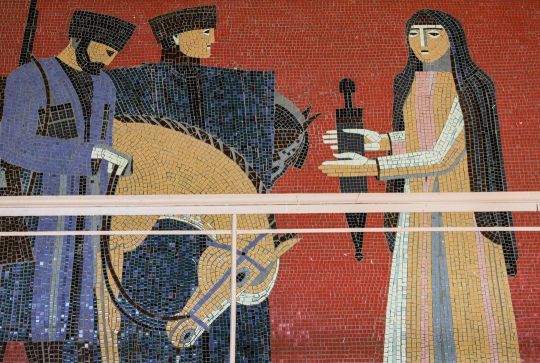
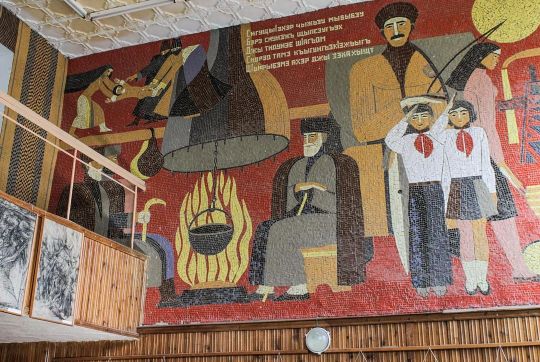

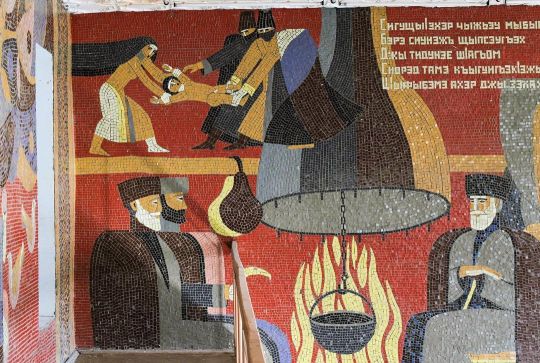

“Soviet mosaic with episodes from the Nart Epic and Circassian history inside the Palace of Culture in the village of Gabukay.
Mosaic author: Teuchezh Kat (Теучеж Кат)
Also on the mosaic there is a poem in the Adyghe language, an approximate translation of which reads as follows:
‘My words did not go far, they lived in my house for a long time. Now, in our kind light, they have acquired new wings, and these words have been heard by many’
Address: 26 Khakurate Street, Gabukay, Republic of Adygea”
Photographed by Kizil Paşa on Instagram, posted 15 November 2021
74 notes
·
View notes
Text
Thanks goes to @h-dgp bc otherwise I'd never live up to my promised posts, in this case a recipe. A long post.
So here's what I'd cook for my mutuals if I could
Psıhaluj, which is dough filled with either cheese, meat, or potato, served with yoghurt and garlic sauce. The dish itself is not super 'rare', variations of it exist in so many cultures, but this is the way our tribe prepares and serves it.
This will be the recipe for the potato version
Start with the filling so it can cool down, otherwise it'll be too hot to handle
For the filling:
4-5 potatoes: boil them and after peeling them take a fork and break them down.
One big onion (or several small ones): finely chop the onions and put them in a pan with a bit of oil on medium heat, until they start to turn translucent at the edges
into the pan add the potatoes, and a good dash of pepper flakes, dried dark purple basil (that's the good stuff, I got a good chunk from my village) and salt. Mix it well. Let it cool.
Also eat that stuff pretending to 'taste it' bc it's good
Now while the filling cools down you can prepare the dough. There are different versions, but I always do the most simple one. Which is:
500 gr of flour
I don't know american dumbass measurements but I think it's half a regular spoon of salt?? I don't know man, I don't stick to a recipe usually. Do whatever you think is approapriate.
mix these two well, then start adding water. How much? I have no idea, just add it bit by bit, by the end the dough should not be sticky. Put it in a plastic bag or smth and let it rest for thirty minutes or so. Or less. I don't write the rules
Ok while the dough and the filling are waiting I usually prepare the sauces. Two types, always, bc that's a rule i WILL stick to.
Sauce one:
Yoghurt, about one and a half cup (or depending on your preference for yoghurt more or less, in my case it's always a bit more)
Add crushed garlic. I could say one clove, but honestly go wild if you want. Just know that sauce no.2 is based on garlic too, so if you can't handle that much stick to one clove (the house is gonna be vampire resistant for the rest of the night, yes, bless my ancestors)
A bit of salt. Just a lil. Mix well. Done.
Sauce Two:
In a pan melt some butter. With some I mean a lot. My people live from animal ag and so I'm used to a lot of butter. Honestly no idea how much. 100 grams? 150 grams? Dunno how that black sheep from the VVitch would try to match my consumption of butter
Before the butter starts to bubble add AT LEAST three or four cloves of garlic (you can add more if you are brave, usually after five cloves I’ll add a bit of water to turn it less intense) and half a spoon of pepper flakes, don't be shy. Put it in there, make sure the butter is hot and let it foam up a bit. Make sure to stir it and don't let the butter turn too dark. If it foams take it off the heat, stir it a bit and let it rest. Done
Ok now that you've got everything ready the troublesome part starts, filling and closing the Psıhaluj.
Take out about a third of the dough, and on a well floured surface, flatten it until it's about 2-3 mm thick. Don't put flour on the top though or you'll have difficulty closing that thing depending on how much water you have used for preparing your dough.
Take a cup with sharper edges, or a cookie cutter, whatever is round. We have a traditional metal cup with engravings for that lmao. Start cutting out circles, they should fit nicely into your palm. Don't do this on all of the dough, just start with a third and then get the filling. If you try to do it one go you'll end up with dry dough disks bc if you havn't done it for years you'll be pretty slow. Ask me how I know.
No. Don't.
Anywayyyyy, take a small spoon, take a good bit of the filling and put it on one side or the center, whatever makes them easier to close for you. If you have difficulty with closing them up tightly take a fork and after putting the Psıhaluj on a surface you can press the end of the fork on the edges to close them up tightly.
Have smth like a big baking sheet or tray ready and put down a kitchen towel. You can put a bit flour on it if the dough has become sticky. They always magically do.
Once you're done with the first third of the dough, repeat the process for the remaining two thirds. All the while make sure to also process the remaining dough from cutting out the circles.
Once you're done it should look smth like this

Ok, by this point you should also have mysteriously found some time to fill a big pot with a lot water and get it to boil. Add salt as you see fit, and then drop in the Psihaluj, again maybe try with a third at first. They should have enough space to swim freely and once they start to float at the top wait maybe another one to two minutes before taking them out (the water should constantly be boiling, your kitchen is gonna look like one of those busy steamy kitchens in tiny back alley restaurants from the movies)
I like to put the finished Psıhaluj into one big casserole/baking dish. Also into that casserole form pour some of that butter garlic sauce on top everytime your done with a third and stir (or shake the entire thing, it's easier) to make sure all the haluj are covered in butter.
Once done with cooking them all and coating them in the sauce I usually put the thing in the middle of the set table and after everyone is seated I'll serve them onto the plates however much anyone likes, starting from the eldest bc I stick to customs. Everyone pours their own yoghurt on top and usually a bit more of the garlic butter to make it look pretty. If you hate wasting stuff, you can take the starchy water you cooked the haluj in, put in some of that dried dark basil and some lemon juice and serve it in a mug, a bit like soup. Not particularly special, but it’s not wasted.
Done. Eat. Be careful of eating too much, that stuff is FILLING. I blame the butter.
Sadly I can't provide you with a picture of the finished product I made myself however here is what i found online (some people like to put dried and crushed peppermint on there as well but that’s mostly non-adyghe people that have us as neighbours)
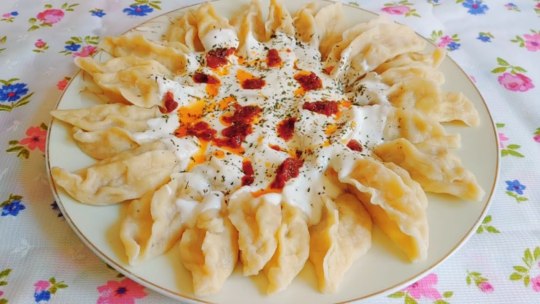
Additional info from our language, Psı means water, haluj means bread. We made water bread. Great.
Also, maybe be careful who you get close to after that meal, bc you are garlic, garlic is you.
#recipe#nt long post#Psıhaluj#adyghe#food#have fun mutuals#it's one of my favourite dishes but it's a bit troublesome to make#Also if anyone cooks this pls pls tag me???#i'd love to see the recipe in action#thank you!#mutual recipes#mutual recipes 001
27 notes
·
View notes